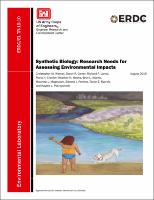Please use this identifier to cite or link to this item:
https://hdl.handle.net/11681/33681Full metadata record
| DC Field | Value | Language |
|---|---|---|
| dc.contributor.author | Warner, Christopher M. | - |
| dc.contributor.author | Lance, Richard F., 1967- | - |
| dc.contributor.author | Crocker, Fiona H. | - |
| dc.contributor.author | Perkins, Edward J. | - |
| dc.contributor.author | Rycroft, Taylor E. | - |
| dc.contributor.author | Pokrzywinski, Kaytee L. | - |
| dc.contributor.author | Carter, Sarah R. | - |
| dc.contributor.author | Meeks, Heather N. | - |
| dc.contributor.author | Adams, Bryn L. | - |
| dc.contributor.author | Magnuson, Matthew L. | - |
| dc.date.accessioned | 2019-08-09T13:21:24Z | - |
| dc.date.available | 2019-08-09T13:21:24Z | - |
| dc.date.issued | 2019-08 | - |
| dc.identifier.govdoc | ERDC/EL TR-19-10 | - |
| dc.identifier.uri | https://hdl.handle.net/11681/33681 | - |
| dc.identifier.uri | http://dx.doi.org/10.21079/11681/33681 | - |
| dc.description | Technical Report | - |
| dc.description.abstract | Synthetic biology and its applications have the potential to greatly improve economic development, public health, environmental stewardship, technological advancement, and many other areas. In May 2017, sixty individuals gathered in Lexington, Massachusetts for a workshop sponsored by the U.S. Army Engineer Research and Development Center (ERDC) to discuss applications of synthetic biology with likely or intended interaction with the environment. Representatives from academia, government agencies, industry, and non-governmental organizations convened to identify knowledge gaps and research needs to assess potential environmental impacts from these technologies. The group discussed challenges in environmental risk assessment, regulation, and community engagement for emerging synthetic biology technologies. The workshop was structured around four hypothetical case studies, including the use of gene drive engineered organisms to control infectious disease vectors, engineered microbes for bioremediation, cell-free applications for advanced chemical production, and engineered viruses for water treatment. Meeting these research needs will facilitate appropriate environmental risk assessment and informed decision making for the development and potential deployment of synthetic biology organisms and components in the environment. | en_US |
| dc.description.sponsorship | United States. Army. Corps of Engineers. | en_US |
| dc.description.tableofcontents | Abstract ..................................................................................................................................................... ii Preface........................................................................................................................................................ v Acronyms ................................................................................................................................................... vi 1 Introduction ........................................................................................................................................ 1 1.1 Background ....................................................................................................................... 1 1.2 Objectives .......................................................................................................................... 2 1.3 Approach ........................................................................................................................... 3 1.4 Scope ................................................................................................................................ 4 2 Common Themes and Research Needs .................................................................................................. 5 2.1 Modeling ........................................................................................................................... 5 2.2 Fate and transport of synthetic biology organisms and components ......................................... 5 2.3 Control and stability of synthetic biology organisms and components ...................................... 6 2.4 Monitoring and surveillance ................................................................................................. 6 2.5 Oversight, regulation, and community engagement ................................................................ 7 3 Case Studies ....................................................................................................................................... 9 3.1 Gene drive engineered organisms to control infectious disease vectors .................................... 9 3.1.1 Introduction ................................................................................................................................. 9 3.1.2 Horizon scanning ........................................................................................................................ 10 3.1.3 Environmental impacts ............................................................................................................... 12 3.1.4 Safety and regulation .................................................................................................................. 14 3.1.5 Community engagement ............................................................................................................. 16 3.2 Case study: microbial engineering for bioremediation .......................................................... 17 3.2.1 Introduction ............................................................................................................................... 17 3.2.2 Horizon scanning ........................................................................................................................ 18 3.2.3 Environmental impact ................................................................................................................. 20 3.2.4 Safety and regulation .................................................................................................................. 22 3.2.5 Community engagement ............................................................................................................. 23 3.3 Case study: cell-free technologies for advanced chemical production .................................... 24 3.3.1 Introduction ............................................................................................................................... 24 3.3.2 Horizon scanning ........................................................................................................................ 24 3.3.3 Environmental impact ................................................................................................................. 26 3.3.4 Safety and regulation .................................................................................................................. 28 3.3.5 Community engagement ............................................................................................................. 28 3.4 Viral systems for water treatment ........................................................................................ 29 3.4.1 Introduction ............................................................................................................................... 29 3.4.2 Horizon scanning ........................................................................................................................ 29 3.4.3 Environmental impacts ............................................................................................................... 31 3.4.4 Safety and regulation .................................................................................................................. 33 3.4.5 Community engagement ............................................................................................................. 34 4 Conclusion ........................................................................................................................................ 35 References ............................................................................................................................................... 38 Appendix A: Acknowledgements and Workshop Attendees ............................................................................. 43 Appendix B: Workshop Agenda ................................................................................................................... 45 Appendix C: Case Studies for Discussion ...................................................................................................... 48 Report Documentation Page | - |
| dc.format.extent | 63 pages / 1.407 Mb | - |
| dc.format.medium | - | |
| dc.language.iso | en_US | en_US |
| dc.publisher | Environmental Laboratory (U.S.) | en_US |
| dc.publisher | Engineer Research and Development Center (U.S.) | - |
| dc.relation.ispartofseries | Technical Report (Engineer Research and Development Center (U.S.)) ; no. ERDC/EL TR-19-10 | - |
| dc.rights | Approved for Public Release; Distribution is Unlimited | - |
| dc.source | This Digital Resource was created in Microsoft Word and Adobe Acrobat | - |
| dc.subject | Synthetic biology | en_US |
| dc.subject | Bioengineering | en_US |
| dc.subject | Research--Planning | en_US |
| dc.subject | Environmental risk assessment | en_US |
| dc.subject | Environmental policy | en_US |
| dc.title | Synthetic biology : research needs for assessing environmental impacts | en_US |
| dc.type | Report | en_US |
| Appears in Collections: | Technical Report | |
Files in This Item:
| File | Description | Size | Format | |
|---|---|---|---|---|
| ERDC-EL TR-19-10.pdf | 1.44 MB | Adobe PDF |  View/Open |